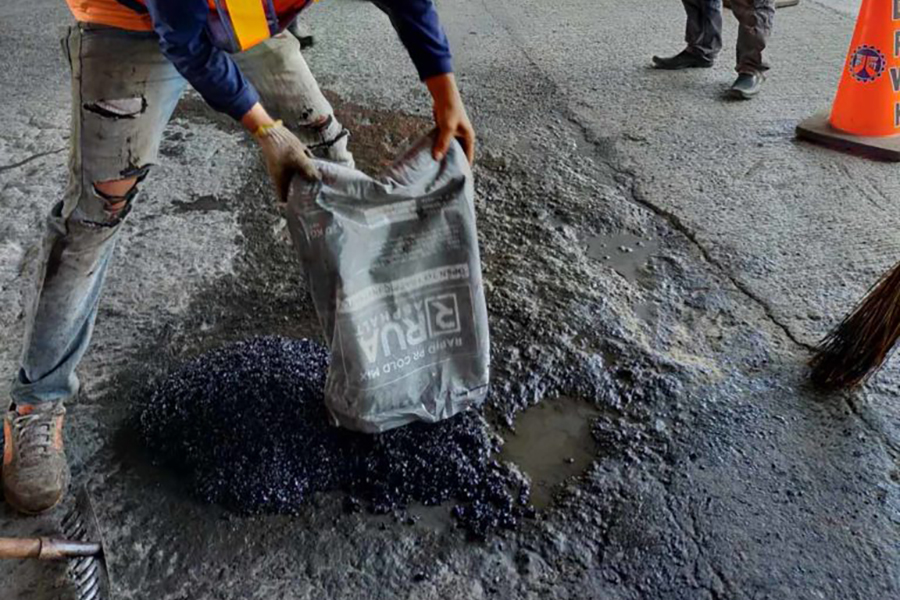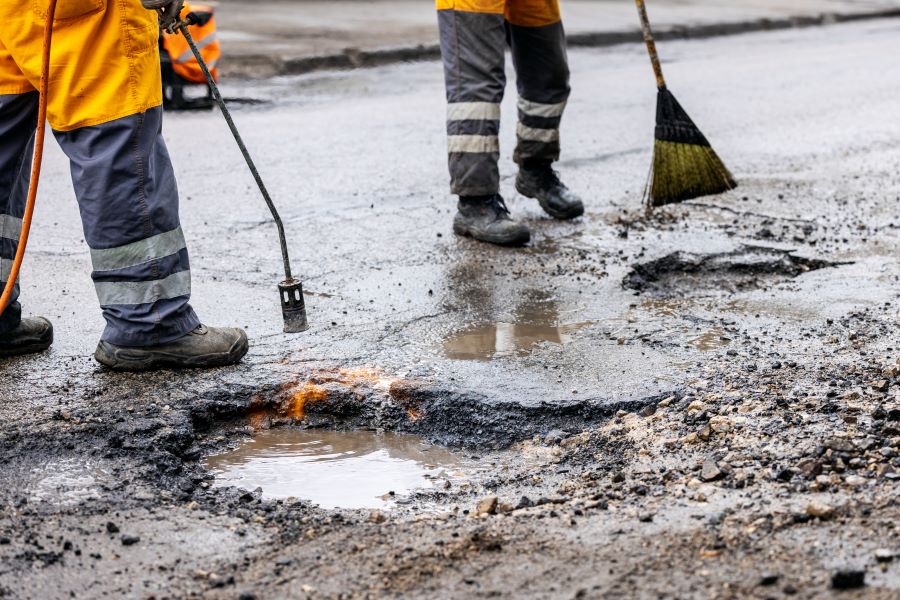A pothole is one kind of damage that usually happens on asphalt surfaces. It is characterized by a bowl-shaped depression on the road or walkway where the asphalt and its binder have weakened.
The Danger of Potholes
Potholes are one of the contributors to the poor road conditions in the Philippines. This type of road crack can come in various sizes, depending on how weak the materials have become and how long it has been left unrepaired. Larger potholes, when left unfixed, can pose a great risk to drivers and pedestrians.
Vehicles’ wheels can fall in potholes, causing the driver to lose control of their car. This may cause them to swerve sideways or—in the case of motorcyclists and bikers—flip over.
Potholes can also injure pedestrians. If they do not see the pothole right away, they may accidentally step or trip on it and cause them to fall. This may result in a sprain or broken bone.
To prevent these accidents from happening, you should act and execute a patch repair job on the road as soon as you see them. Fixing small potholes before they develop into larger ones is key to keeping drivers and motorists safe.
There are two methods that you can choose from when conducting road patching repair tasks. Each one differs based on the material used to patch up the asphalt depressions.
Cold Mix Asphalt
You can use cold patch asphalt to repair small and large potholes on pavements. This material can be used as temporary and permanent pothole repair solutions.
Cold mix asphalt is a form of cold mix bitumen that can be applied on roads and walkways without being heated up. It is ready for use straight from the bag, making it a fast and efficient choice for repairing potholes.

Fewer Resources Needed
Because cold patch asphalt does not require heat, you do not have to worry about acquiring or renting cooking machines and compactors to complete your tasks. It will also take less manpower to repair a pothole on the road because cold mix asphalt is easy to use and apply.
Choosing cold mix asphalt to repair potholes will also allow you to save money. You would not need to spend on obtaining additional equipment nor pay for more people who will work on your pothole repair project.
Environmentally Friendly
Since cold mix asphalt does not require heat from any machine, using this road patching material can help you reduce your carbon footprint. Cooking machines and compactors emit greenhouse gasses, which can be harmful to the environment. Without these pieces of equipment, you can have peace of mind knowing that you are not adding to greenhouse emissions while also being able to repair potholes.
Reduced Downtime
Repairing a road involves closing off a part or the whole of it to motorists and pedestrians. When roads and walkways are closed for a long time, it can cause inconvenience to drivers and pedestrians. It can even cause heavy traffic in other parts of the area.
When you choose to use cold mix asphalt, you would not have to close off roads or parts of it for a long time. This is possible because this material dries fast and does not need to be cured. In just a few hours or even minutes, you can reopen the road to motorists and pedestrians.
How to Fix Potholes on Roads Using Cold Mix Asphalt
Now that you know the benefits of using cold mix asphalt, it’s time to understand how to use this solution for your road repair needs.
Listed below are the steps for using cold mix asphalt to patch up your roads:
- Use cleaning tools to clear out the pothole of any debris, dirt, and water.
- Shovel in the cold mix asphalt into the damaged area.
- Level the area at least 25% higher than the depth of the pothole for easy compaction.
- Use a compacting instrument over the repaired area.
- Wait 10 minutes for the mixture to set.
- Reopen the lane to motorists and pedestrians.
Hot Mix Asphalt
Another material you can use in repairing potholes is hot mix asphalt. This component is often used in large-scale paving applications but can also be used to patch up parts of the road.
Longer-Lasting Solution
Unlike cold mix asphalt, hot mix asphalt needs to be heated up in a cooking machine and cured. These extra steps might mean that you need to spend more money and time repairing a pothole, but they are worth the resources.
The curing process allows the material to bind with the existing asphalt surface better. This means that hot mix asphalt creates a more permanent road patch solution to potholes that can last for years.
Hot mix asphalt can also address the underlying problem that caused the pothole in the first place. Additionally, this material can help prevent potholes from appearing again, saving you more time and money in the long run.
Because of the durability it offers, hot mix asphalt is perfect for high-traffic roads and highways. It can also be used on roads frequented by heavy vehicles, such as trucks.
Flexibility
Hot mix asphalt is a great weather-resistant material that can be used in repairing potholes. It does not crack or deteriorate easily even when exposed to extreme temperature changes. Because of this unique property, this road patching material is perfect for roads located in areas that experience drastic weather changes.
Quick Cooldown Time
Another reason to choose hot mix asphalt in repairing potholes is its quick cooldown time. Upon applying this material on potholes, it can be cooled down and cured in a few hours or minutes. This allows for reduced time for road closures, meaning less inconvenience on the part of motorists and pedestrians.

How to Fix Potholes on Roads Using Hot Mix Asphalt
Using hot mix asphalt for road patching requires more steps on your part, although the results are sturdier.
Enumerated below are the steps for using Rua Seguridad’s Hot Mix Asphalt on road patching operations.
- Heat the hot mix in the asphalt layering machine.
- While waiting for the hot asphalt mix to heat up, clear the pothole of debris, dirt, and leaves.
- Allow the asphalt machine to roll over the pothole.
- Using a compacting tool, compress the asphalt into the newly repaired area.
- Wait for the mixture to set.
- Open the road for motorists and pedestrians to use.
Choose Which Material to Use
Deciding between the two types of materials can be confusing at first. To make it easier for you, you should always consider your needs and the available resources.
If you do not have enough manpower and the equipment to repair the pothole, use a cold mix asphalt road patching solution. On the other hand, if you can spare some resources in manpower and machines, choose hot mix asphalt. You should also use this material if the pothole to be repaired is in an area that experiences drastic temperature changes throughout the year.
For more information on these materials, contact us today. Our experts can help you decide between cold and hot mix asphalt.



